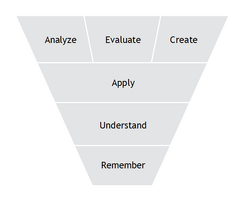No edit summary |
No edit summary |
||
| Line 3: | Line 3: | ||
[[Image:BloomsCognitiveDomain.PNG|right|thumb|250px|Categories in the cognitive domain of Bloom's Taxonomy (Anderson & Krathwohl, 2001)]] |
[[Image:BloomsCognitiveDomain.PNG|right|thumb|250px|Categories in the cognitive domain of Bloom's Taxonomy (Anderson & Krathwohl, 2001)]] |
||
| − | The '''Taxonomy of Educational Objectives''', often called '''Bloom's Taxonomy''', is a |
+ | The '''Taxonomy of Educational Objectives''', often called '''Bloom's Taxonomy''', is a classification of the different objectives and skills that [[education|educators]] set for students. The taxonomy was proposed in [[1956]] by [[Benjamin Bloom]], an [[educational psychology|educational psychologist]] at the University of Chicago. Bloom's Taxonomy divides educational objectives into three "domains:" Affective, Psychomotor, and Cognitive. Within each domain are different levels of learning, with higher levels considered more complex and closer to complete mastery of the subject matter. A goal of Bloom's Taxonomy is to motivate educators to focus on all three domains, creating a more [[Holism|holistic]] form of education. |
===Affective=== |
===Affective=== |
||
Revision as of 10:37, 18 August 2006
Assessment |
Biopsychology |
Comparative |
Cognitive |
Developmental |
Language |
Individual differences |
Personality |
Philosophy |
Social |
Methods |
Statistics |
Clinical |
Educational |
Industrial |
Professional items |
World psychology |
Educational Psychology: Assessment · Issues · Theory & research · Techniques · Techniques X subject · Special Ed. · Pastoral

Categories in the cognitive domain of Bloom's Taxonomy (Anderson & Krathwohl, 2001)
The Taxonomy of Educational Objectives, often called Bloom's Taxonomy, is a classification of the different objectives and skills that educators set for students. The taxonomy was proposed in 1956 by Benjamin Bloom, an educational psychologist at the University of Chicago. Bloom's Taxonomy divides educational objectives into three "domains:" Affective, Psychomotor, and Cognitive. Within each domain are different levels of learning, with higher levels considered more complex and closer to complete mastery of the subject matter. A goal of Bloom's Taxonomy is to motivate educators to focus on all three domains, creating a more holistic form of education.
Affective
Skills in the affective domain describe the way people react emotionally and their ability to feel another living thing's pain or joy. Affective objectives typically target the awareness and growth in attitudes, emotion, and feelings.
There are five levels in the affective domain moving through the lowest order processes to the highest:
- Receiving - The lowest level; the student passively pays attention. Without this level no learning can occur.
- Responding - The student actively participates in the learning process, not only attends to a stimulus, the student also reacts in some way.
- Valuing - The student attaches a value to an object, phenomenon, or piece of information.
- Organizing - Students can put together different values, information, and ideas and accommodate them within their own schema; comparing, relating and elaborating on what has been learnt.
- Characterizing - The student has held a particular value or belief that now exerts influence on their behaviour so that it becomes a characteristic.
Psychomotor
Skills in the psychomotor domain describe the ability to physically manipulate a tool or instrument like a hand or a hammer. Psychomotor objectives usually focus on change and/or development in behaviour and/or skills.
Bloom and his colleagues never created subcategories for skills in the psychomotor domain, but since then other educators have created their own psychomotor taxonomies [1].
Cognitive
Skills in the cognitive domain revolve around knowledge, comprehension, and "thinking through" a particular topic. Traditional education tends to emphasize the skills in this domain, particularly the lower-order objectives.
There are six levels in the taxonomy, moving through the lowest order processes to the highest:
- Knowledge
- Exhibit memory of previously-learned materials by recalling facts, terms, basic concepts and answers
- Knowledge of specifics - terminology, specific facts
- Knowledge of ways and means of dealing with specifics - conventions, trends and sequences, classifications and categories, criteria, methodology
- Knowledge of the universals and abstractions in a field - principles and generalizations, theories and structures
- Comprehension
- Demonstrative understanding of facts and ideas by organizing, comparing, translating, interpreting, giving descriptions, and stating main ideas
- Translation
- Interpretation
- Extrapolation
- Application
- Using new knowledge. Solve problems to new situations by applying acquired knowledge, facts, techniques and rules in a different way
- Analysis
- Examine and break information into parts by identifying motives or causes. Make inferences and find evidence to support generalizations
- Analysis of elements
- Analysis of relationships
- Analysis of organizational principles
- Synthesis
- Compile information together in a different way by combining elements in a new pattern or proposing alternative solutions
- Production of a unique communication
- Production of a plan, or proposed set of operations
- Derivation of a set of abstract relations
- Evaluation
- Present and defend opinions by making judgments about information, validity of ideas or quality of work based on a set of criteria
- Judgments in terms of internal evidence
- Judgments in terms of external criteria
See also
Reference
Taxonomy of Educational Objectives: The Classification of Educational Goals; pp. 201-207; B. S. Bloom (Ed.) Susan Fauer Company, Inc. 1956.
da:Taksonomi for indlæringsmål es:Taxonomía de objetivos de la educación gl:Taxonomía de Bloom
| This page uses Creative Commons Licensed content from Wikipedia (view authors). |